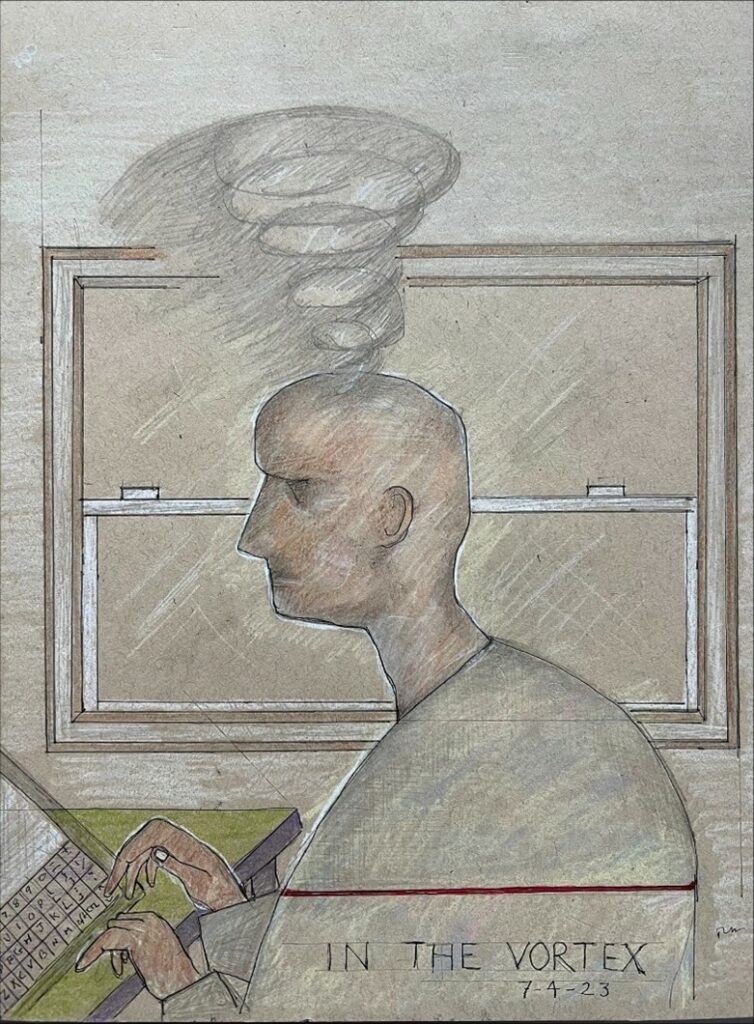Becoming aware

Emotions and feelings are dimensions of my daily life experience. In my practice of meditation, everything that is an aspect of my behavior, relationships, perceptions, and emotions are grist for the mill in meditation.
I become aware from meditating of how I express my feelings. How my feelings are communicated and can affect my interaction with others also can become apparent . Meditation, because it is a practice that encourages going further than the habitual and familiar, helps me to recognize the emotions that move within me.
Do emotions have a place in meditation?
I think there might be a misconception about feelings and emotions in the practice of meditation. A common view is that emotions have no place in meditation. In this line of thinking, meditation is a practice of quieting the mind, becoming still, and emptying oneself of all feeling and thought. Being in silence, listening to the voice of my soul are states within the meditation exercise. Additionally, awareness of my thoughts, feelings and interactions are an inner movement within meditation that sharpens my awareness of how I live. Becoming conscious of my thoughts, feelings and actions means that who and how I am as a person is not stagnant but a dynamic, changeable way of being. Awareness of emotions and feelings are an important aspect of meditation for me.
Are feelings and emotions the same?
In our everyday language the words feelings and emotions are used interchangeably. I will also use feelings and emotions interchangeably in this blog. However, by definition feelings and emotions are not considered to be the same. Feelings are the sensations experienced at a conscious level. I am aware of my feelings as I live my life. By definition, emotions are unconscious, what is at a deeper level, beneath the surface.
Emotions and feelings can seem opposite to the state of quiet in meditation. However, they do not oppose the practice of meditation. Emotions and feelings are a natural and necessary dimension of the practice of meditation because feelings are a dynamic expression of living. Meditation is about learning how to live from a more aware state of mind.
Is it helpful to bring feelings and emotions into meditation?
In my personal experience I find it not only helpful but expansive and life changing to bring feelings and emotions into meditation. A primary reason for why I meditate is because I want to live with greater awareness, have a more uplifted perspective and live in a way that is helpful and not hurtful to others. Since I want to transform the way I live, I don’t leave my thoughts, feelings and actions to random chance. In the practice of meditation, I learn to pay attention.
From meditating, self-observation and feedback from others, I realize that I am a person who tends to lead with my feelings, not always with thoughts. My feelings/emotions can be strong.
Have you ever felt flooded by strong emotions?
I certainly have. To site a couple examples. When I am with someone who likes to chat, to talk and talk and talk, I feel my body tighten, I begin to fidget. Even though I understand that this is the personality of the other person, my emotional reaction is strong. I am not a big chatterer, and I feel agitated, trapped. On a scale of one to ten, my inner emotional reactions elevate steadily from 2 to 6 to maybe a 9. My feeling is strong, and I expend energy doing my best not to show the discomfort and negative reaction I feel. This, of course, only adds to my frustration.
Another example, when any one of our three adult children go through the normal array of difficulties, stresses in their lives, I can become flooded with worry that circles in my mind. The worry affects my ability to concentrate, read a book, sleep at night. My emotional reaction is very strong. Or on a more positive note, when I watch a baby clap her hands with great excitement, I can be moved to tears because I feel awed by the beauty of their delight. These are only a few examples of what I mean by being flooded by strong emotions.
In my opinion it is not wrong to feel strong emotions, in fact it is fairly typical. But by paying attention in meditation to my emotions I become more aware of how those feelings have an impact on how I live, and how I relate to others.
Does everyone feel strong emotions?
My answer to that question is yes and no. From observation, it seems to me that some emotions are typical to the human experience. For example – happiness, sadness, fear, anger, grief, uncertainty are familiar feelings. Everyone does not experience emotions in the same way.
In my work as a therapist with adults and children, I have learned that the way individuals connect with their emotions can depend on many factors – like age, life circumstances, trauma, temperament and personality, family dynamics as well as many others. For some individuals, emotions can be overpowering, even debilitating. It seems that emotions seem to have a life of their own, and can fuel impulsive actions. Other adults and children take emotions in stride. These are people who tend to say “I don’t let things bother me.” For still others, feeling strong emotions can be frightening and can be denied or repressed.
But I wonder if there is something I can learn from emotions/feelings? And even a more radical thought, is it possible to appreciate and value emotions?
Can meditation help me understand and cope with my emotions?
Working with my feelings/emotions in meditation has contributed to having greater compassion for myself and others. To state the obvious, emotions are as integral to the human experience as are thoughts and physical movements and sensations.
Here is an example of how I work with emotions in meditation:
I sit in meditation. Taking the posture of meditation, I sit in silence. Today I intentionally bring a specific emotion I have been feeling into the meditation. Then I focus on an actual experience from my life.
Now that I am partially retired, I have more time available. This allows me to have many creative projects I like to pursue in my life. I use my time to write and to do several different types of fiber arts, including weaving, needlepoint, and sewing. I love working with color and texture. However, I make frequent mistakes. My emotional reaction to making mistakes is feeling frustrated and inadequate. The feelings of frustration and inadequacy are what I meditate about.

How and why do I meditate?
I meditate about my emotions of frustration and inadequacy because those feelings arouse an unhelpful state of mind. And not only for me. When I’m so frustrated, I become grumpy. This has a ripple effect on others I am with. In the first step of the discursive meditation that is taught in Cafh, I invoke the Divine Mother. I imagine sitting in the silence of her Presence. From that inner posture, I ask for help in seeing myself clearly and honestly. I see myself attempting a new and difficult knitting stitch. My fingers are tight and get twisted in the yarn. As the yarn pulls tighter and tighter in my hand, I feel my body getting tense and tight. I imagine I hear that I say, “I can’t do anything. I’m no good at this. I’m a failure.”
In meditation, I ask to be free of this pattern of negative discourse within myself. Followed by a short period of silence, in the response, I see myself putting aside the knitting project. I breathe in and out. I receive a response that making mistakes is how I learn. As I momentarily put aside the project, I also put aside the desire for perfection that until that moment I didn’t realize I was feeling.
People meditate for different reasons. People seek different things. I meditate because I want to live with love. Is love an emotion? Is love a feeling? I experience love as both feeling and emotion and as an orientation to how to live. To live with love, I need to understand what love means.
What does love mean?
You and I and the next person, and the next may understand love differently. How do you understand what love is? For me love is about knowing myself so well, I am no longer in my own way. I come to know my thoughts, emotions, reactions and responses with a mix of compassion and dispassion. Love for me is making the conscious choice and effort within the interior of my soul to move myself out of the way so I can be present for souls and all the manifestations of life. What emotion do I feel when I think about this? I feel joy. The joy of being alive and having learned from the practice of meditation how to make the ongoing effort to notice, attend, respond wholeheartedly.
The joy of being alive
From meditating I learned that I have a limited view of what emotions are. Over the years of meditating, I discovered emotions that I didn’t consider previously. For example, if the emotion of frustration arises as I meditate, I go deeper into the feeling to find there is also disappointment because of idealizations I hold. Sometimes I encounter expectations that were held beneath the surface. I may become aware of longings to be free, or wanting to change my impulsive emotional reactions in order to connect with another human being. I see that my frustration can rub off on others and cause them unhappiness.
How can I discover new depth in emotions?
Are disappointment, idealization, expectations, the longing to be free and wanting to connect with others experienced as emotions? More than emotions I think these are states of being. I have learned that awareness of emotions serves as an entrance into what lies beneath the surface. It is my view that through the practice of meditation, the soul can encounter unrealized, as yet undeveloped affective states of awareness such as desolation felt by those who suffer, disattachment from what I cling to in life, making choices about how to live integrated with my intention to love, feelings of consolation, and joy, to name a few. These affective states of awareness are integral to meditation practice in Cafh.
What is the parallel between emotions and colors?
I sometimes try to imagine what life would be like if colors did not exist. I don’t do this often because I am so grateful for colors. What if there were no colors at all in the physical environment, we take in visually? What if there were no vibrant greens and shades of blue? No rosy pink children’s cheeks. Can you imagine what a loss that would be? I find the thought of a world in only black and white or in light and shadow disturbing. I imagine such a world as bland or flat, lacking a dynamic variation. When I think about how much color adds to the visual world, I feel grateful for this kaleidoscopic dimension. Color feels like a bonus, an extra delight that adds dimension, variation, shades of difference, uniqueness an awesome beauty to the physical world.
Not all emotions are pleasant or easy to feel. But emotions are part of being human. In my view, emotions make life interesting and bring a unique dimension that has much to teach about being human.
About the Author(s)
Allegra Magrisso is a social worker, therapist, long time meditator, mother and grandmother.





